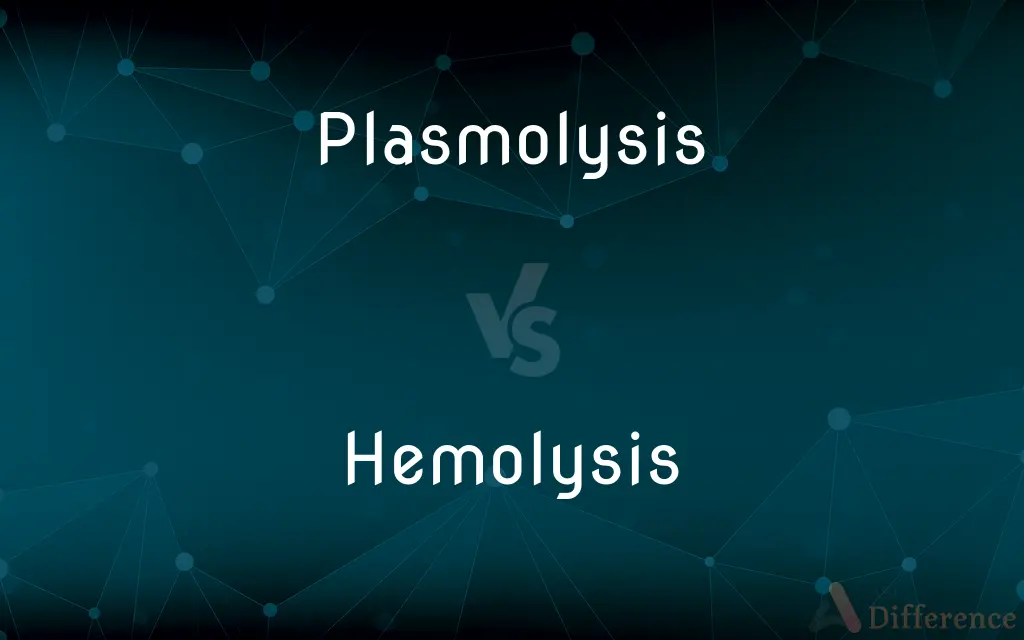Plasmolysis vs. Hemolysis — What's the Difference?
Edited by Tayyaba Rehman — By Fiza Rafique — Updated on April 15, 2024
Plasmolysis involves the contraction of the cell's cytoplasm due to water loss in hypertonic solutions, affecting mainly plant cells; hemolysis refers to the rupture of red cells, releasing hemoglobin, typically caused by hypotonic solutions.

Difference Between Plasmolysis and Hemolysis
Table of Contents
ADVERTISEMENT
Key Differences
In plasmolysis, the integrity of the cell wall in plants prevents the cell from bursting, maintaining the cell's basic structure despite severe shrinkage. On the other hand, red cells lack a rigid cell wall, making them more susceptible to bursting under similar conditions.
Plasmolysis is a reversible process where the cell can regain its turgid state once normal conditions are restored. In contrast, hemolysis leads to the irreversible destruction of red cells, which can result in significant clinical complications.
The outcome of plasmolysis can be observed under a microscope as the cytoplasm pulls away from the cell wall; however, hemolysis is often detected by a clear solution turning red due to released hemoglobin.
While plasmolysis is a defense mechanism in plants against excessive salt or sugar concentrations, hemolysis can indicate pathological states or reactions to foreign substances in humans.
Comparison Chart
Cell Type Affected
Mainly plant cells
Red cells (erythrocytes)
ADVERTISEMENT
Solution Type
Hypertonic
Hypotonic
Reversibility
Often reversible
Irreversible
Typical Causes
High solute concentrations outside the cell.
Enzymatic, osmotic, or immune reactions.
Compare with Definitions
Plasmolysis
A process affecting plant cells in hypertonic solutions.
Plasmolysis can be prevented by watering plants regularly.
Hemolysis
Detected by the color change in solutions.
The solution turns red during hemolysis due to hemoglobin release.
Plasmolysis
A protective mechanism in plants.
Plasmolysis helps plants survive in saline environments.
Hemolysis
Occurs in hypotonic solutions affecting erythrocytes.
Freshwater exposure can cause hemolysis in blood samples.
Plasmolysis
Contraction of the cell's cytoplasm due to water loss.
Observing onion cells in a salt solution can show plasmolysis.
Hemolysis
Indicates pathological or immunological issues.
Hemolysis can signal an immune response in the body.
Plasmolysis
Involves pulling away of the cytoplasm from the cell wall.
Plasmolysis is visible under a microscope as the cell content retracts.
Hemolysis
Results in the destruction of cells.
Hemolysis is a critical factor in diagnosing certain diseases.
Plasmolysis
Reversible dehydration of cells.
Plasmolysis reversed once the plant is watered again.
Hemolysis
Lysis of erythrocytes with the release of hemoglobin
Plasmolysis
Plasmolysis is the process in which cells lose water in a hypertonic solution. The reverse process, deplasmolysis or cytolysis, can occur if the cell is in a hypotonic solution resulting in a lower external osmotic pressure and a net flow of water into the cell.
Plasmolysis
Shrinkage or contraction of the protoplasm away from the wall of a living plant or bacterial cell, caused by loss of water through osmosis.
Plasmolysis
(biology) the shrinking of protoplasm away from the cell wall of a plant or bacterium due to water loss
Common Curiosities
Can plasmolysis be reversed?
Yes, plasmolysis is generally reversible if the plant cell is returned to an isotonic environment.
How can plasmolysis be detected?
Plasmolysis can be observed under a microscope where the cell's cytoplasm can be seen contracting and pulling away from the cell wall.
What are the effects of hemolysis in the human body?
Hemolysis can lead to anemia, jaundice, or other serious health issues depending on the extent and duration of the red cells destruction.
What causes hemolysis?
Hemolysis can be caused by various factors including osmotic imbalance, enzymatic activity, or immune reactions.
What role does the cell wall play in plasmolysis?
The cell wall in plant cells provides structural support and prevents the cell from bursting in hypertonic solutions, unlike in animal cells.
What is plasmolysis?
Plasmolysis is the process where plant cells lose water in a hypertonic solution, causing the cell membrane to shrink away from the cell wall.
What symptoms indicate hemolysis in individuals?
Symptoms of hemolysis include fatigue, weakness, darker urine, and skin yellowing.
Can hemolysis be intentionally induced?
Yes, hemolysis can be intentionally induced in laboratory settings for various diagnostic tests.
How do plants benefit from plasmolysis?
While typically a stress response, plasmolysis can help plants manage and survive in overly saline or sugary environments.
Is hemolysis immediately harmful?
Hemolysis can be harmful if it leads to significant loss of red cells, affecting oxygen transport and causing metabolic imbalances.
Share Your Discovery

Previous Comparison
Acumen vs. Insight
Next Comparison
Meat vs. SteakAuthor Spotlight
Written by
Fiza RafiqueFiza Rafique is a skilled content writer at AskDifference.com, where she meticulously refines and enhances written pieces. Drawing from her vast editorial expertise, Fiza ensures clarity, accuracy, and precision in every article. Passionate about language, she continually seeks to elevate the quality of content for readers worldwide.
Edited by
Tayyaba RehmanTayyaba Rehman is a distinguished writer, currently serving as a primary contributor to askdifference.com. As a researcher in semantics and etymology, Tayyaba's passion for the complexity of languages and their distinctions has found a perfect home on the platform. Tayyaba delves into the intricacies of language, distinguishing between commonly confused words and phrases, thereby providing clarity for readers worldwide.















































